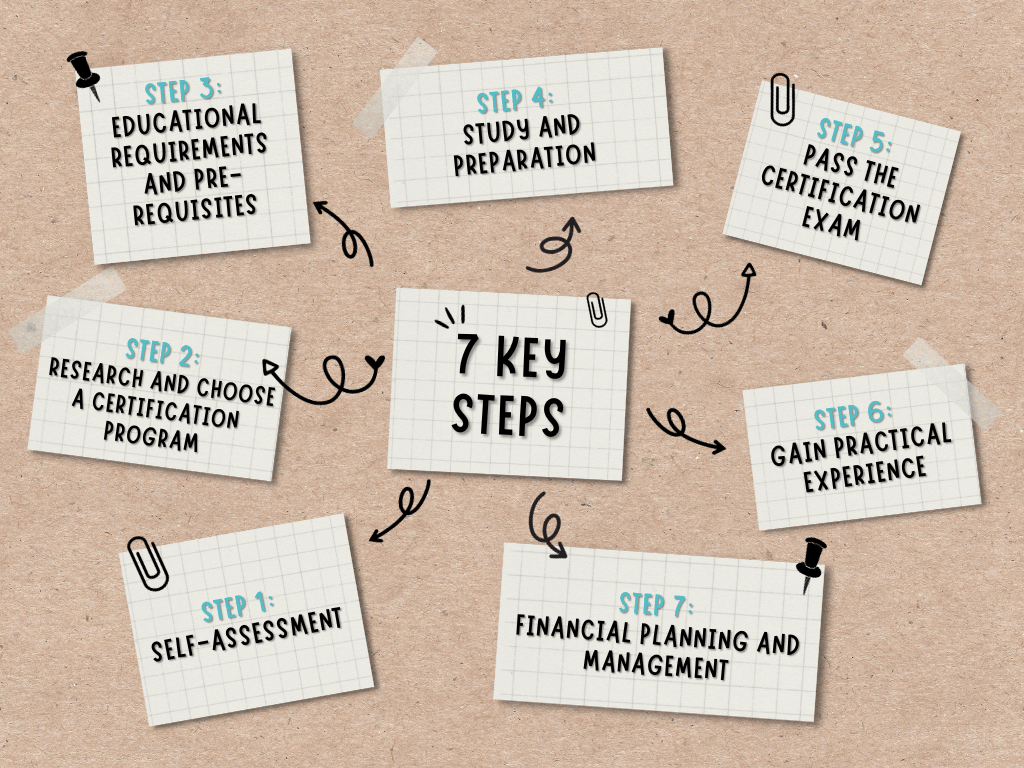Welcome to your quick and easy 7-step guide on how to become a personal trainer! If you’re eager to turn your passion for health into a fulfilling career, you’ve come to the right place. This blog will outline the seven key steps you need to follow, from getting the right education to gaining hands-on experience, to become a qualified personal trainer.
Ready to get started? Let’s go!
What is the role of a personal trainer?
A personal trainer assesses a client’s fitness level, creates customized workout plans, and provides guidance on proper exercise techniques and nutrition. They also serve as motivators and accountability partners, aiming to help clients achieve their specific fitness goals. Their role encompasses both physical training and emotional support.
How long does it take to become a Personal trainer?
Becoming a personal trainer generally takes a few months to a year. You must complete a certification program from a recognized organization. Passing a comprehensive exam is usually required for certification. Additional steps may include obtaining CPR/AED certification and gaining practical experience.
Income and Career Prospects for Personal Trainers
Potential Salary Ranges
After you become a certified personal trainer, your income can vary based on different factors. You could earn anywhere from $30,000 to $70,000 a year. Working in big cities usually means higher pay because the cost of living is higher and people there generally have more money.
Job Outlook
More people are becoming interested in being healthy and fit, so the need for personal trainers is growing. This means there will likely be more job opportunities for personal trainers in the future. This trend isn’t limited to gyms; online health and workout platforms are also making it easier for people to get fitness guidance from anywhere.
How to Become a Personal Trainer: 7 Key Steps

Step 1: Self-Assessment and Decision Making
Before you decide to enter this career, you’ll need to understand your fitness level, interpersonal skills, and commitment.
Key Point: Personal training is as much about communication and motivation as it is about fitness.
Once you’ve evaluated your suitability for this career, you can take further steps with confidence, knowing you’ve chosen the right path.
Step 2: Research and Choose a Certification Program
It’s crucial to research which certification programs are considered credible and respected in the industry.
Key Point: Select a program that is accredited by a reputable organization.
Considering factors like cost, study mode, and duration will help you make an informed decision that aligns with your career goals. Examples of certification programs and courses include:
1. American Council on Exercise (ACE) Certified Personal Trainer
2. National Academy of Sports Medicine (NASM) Certified Nutrition Coach
3. International Sports Sciences Association (ISSA) Specialist in Exercise Therapy
The cost to become a personal trainer varies, ranging from $400 to $2,000 for certification courses. Prices can differ based on the certification body and location.
Step 3: Educational Requirements and Pre-Requisites
Make sure you check if there are any educational prerequisites or other qualifications before enrolling in a course.
Key Point: Some programs require a high school diploma and CPR/AED certification.
Meeting these requirements is crucial for admission and could be legally mandated in some jurisdictions. Examples of educational prerequisites and other qualifications include:
1. Programs like ACE and NASM require you to have valid CPR and AED certifications.
2. Some advanced courses might require a practical experience in the field.
3. Courses such as the ISSA may require a basic understanding of human anatomy and physiology.
Carefully checking and fulfilling these prerequisites will ensure that you are eligible and well-prepared for the certification program of your choice.
Step 4: Study and Preparation
After enrollment, you will need to commit to studying the course material rigorously.
Key Point: Make use of all available resources, including study guides and practice exams, to prepare for the certification test.
Practical experience, gained by volunteering or shadowing, can provide valuable insights that can’t be learned from textbooks alone.
Step 5: Pass the Certification Exam
Study diligently to prepare for the exam, which will test your knowledge of various subjects.
Key Point: The exam usually includes questions on exercise physiology, training methods, and ethics.
Passing this certification is a testament to your theoretical and practical proficiency in personal training.
Step 6: Gain Practical Experience
After getting certified, the next logical step is to gain practical experience in the field.
Key Point: Working at a gym or a health club initially can provide you with on-the-job training and help you build a client base.
This experience is crucial for refining your skills, building a portfolio, and making industry contacts.
Step 7: Financial Planning and Management
Once your career is in full swing, financial management becomes increasingly important.
Key Point: Create a financial plan that covers operating costs, taxes, and savings for the future.
Whether you’re an independent contractor or own your own business, sound financial planning can help you sustain your career in the long term.
Financial Planning for Aspiring Personal Trainers
If you’re planning to become a personal trainer, understanding the financial aspects is crucial. Here’s a quick rundown to help you out:
 1. Plan for your initial expenses, which include gym equipment, a location, and operational costs like utilities and insurance. Knowing these costs upfront helps you plan better.
1. Plan for your initial expenses, which include gym equipment, a location, and operational costs like utilities and insurance. Knowing these costs upfront helps you plan better.
2. Your income will depend on various factors, such as location and the specialized services you offer. Research what trainers in your area charge to get a competitive edge.
3. When you have enough regular clients, think about making your business bigger. You could hire more trainers to help with more clients or start online classes to make more money.
Build Your Personal Training Business
As you become more experienced, you might consider launching your own personal training business. Establishing your niche and creating a comprehensive business plan are pivotal steps in building your brand. Effective marketing and continued education are also critical for attracting clients and staying up-to-date with the latest trends in the industry.
How to Market Your Personal Training Business
Make a simple website. Show your training certificates and what services you offer, and give people a way to contact you. Use Instagram and Facebook to show what you can do. Post workout tips and happy client stories to get more people interested.
Make Connections
• Team up with gyms near you. They send clients your way, and you give the gym a good trainer to suggest.
• Join forces with a food expert. Clients like getting exercise and meal tips all in one place.
• Exceptional customer service and regular follow-ups can go a long way in retaining clients.
Legal Steps for Starting a Personal Training Business
Business Licenses: Check local and state rules to see if you need a business license.
Insurance: Get liability insurance for legal safety and health insurance for yourself.
Contracts and Paperwork: Make sure you have signed contracts with clients and keep your business records straight.
Challenges Faced and Overcome
Breaking into a saturated market and overcoming initial financial hurdles are common challenges that can be overcome with perseverance and smart strategies.
Real-Life Success Stories in Personal Training
Career Change: A lot of top trainers used to do completely different jobs. Read more.
Starting Young: Some trainers start right after high school and do well. Learn how.
Frequently Asked Questions (FAQs)
How much does it cost to become a personal trainer?
The cost of becoming a personal trainer can range from $400 to $2,000 for the certification course alone. Additional expenses may include study materials, exam fees, and optional workshops. You may also need to pay for CPR/AED certification, which can cost around $50 to $100. These costs can vary depending on the certification organization and geographic location.
How to become a personal trainer in California?
To become a personal trainer in California, you’ll need to complete a certification program accredited by a reputable organization like ACE or NASM. After passing the certification exam, you must obtain CPR/AED certification. California doesn’t have state-specific requirements, so national certification is generally accepted.
How to become a personal trainer and nutritionist?
To become a personal trainer, complete a certification program and pass an exam from a reputable organization. For nutritionist credentials, earn a degree in nutrition or a related field and obtain relevant certifications. Both roles often require CPR/AED certification and ongoing continuing education.
How to become a personal trainer in Texas?
To become a personal trainer in Texas, complete a certification program from a recognized organization like ACE, NASM, or ACSM. Pass the certification exam to become officially certified. CPR/AED certification is also generally required but Texas has no state-specific regulations for personal trainers.
Do Personal Trainers need a college degree?
No, a college degree is not a mandatory requirement although it can be beneficial.
Read More: How to start a Business with no money
- Secret Websites to Make Money in 2025 - April 30, 2025
- Webull vs Robinhood: Which one is better in 2025? - February 14, 2024
- Bubble Cash Review For 2024: Is it Legit or a Scam? - December 30, 2023






